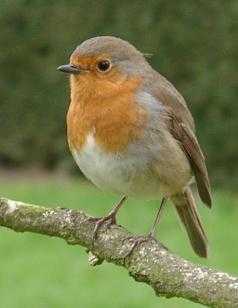Erithacus
| Erithacus | |
|---|---|
 | |
| European robin | |
| Scientific classification | |
| Kingdom: | Animalia |
| Phylum: | Chordata |
| Class: | Aves |
| Order: | Passeriformes |
| Family: | Muscicapidae |
| Genus: | Erithacus Cuvier, 1800 |
| Species | |
The robins are small passerine birds comprising the genus Erithacus. They were formerly classed as members of the thrush family, but now considered to be Old World flycatchers of the chat subfamily (Saxicolinae).
The vernacular name "robin" is also applied to some other chats, as well as certain thrushes and some unrelated songbirds; see Robin#Birds.
The three or four species presently placed here are:
- European robin, Erithacus rubecula
- Tenerife robin, Erithacus (rubecula) superbus
- Japanese robin, Erithacus akahige
- Ryukyu robin, Erithacus komadori
The two Asian species were formerly considered to be members of the genus Luscinia; apparently, both genera need to be split and rearranged. The European species would then be the only remaining Erithacus, whereas the East Asian species are closely related to some species from the genus now classed as Luscinia, for example the Siberian blue robin (Luscinia cyane) and would form a new genus.[1]
These species are stocky small birds with an upright stance and short frequently cocked tail. They have a plain brown back, and a red or black face and breast contrasting with whitish or grey underparts. The females of the Asian species are much duller than the males, but in the European robin differences between the sexes are minimal and restricted to the shape of the boundary between the red and brown plumage on the forehead.
Erithacus robins are territorial woodland birds which build a neat cup nest in a hole or on the ground, and have a life expectancy of just over a year. They watch for insects, worms and other invertebrates from a low perch, and feed mostly on the ground, hopping on strong legs with frequent stops.
Fossil record
Erithacus minor (Pliocene of Beremend, Hungary) [2]
Footnotes
- ↑ Seki, Shin-Ichi (2006). "The origin of the East Asian Erithacus robin, Erithacus komadori, inferred from cytochrome b sequence data". Molecular Phylogenetics and Evolution 39 (3): 899–905. doi:10.1016/j.ympev.2006.01.028. PMID 16529957.
- ↑ Kessler, E. 2013. Neogene songbirds (Aves, Passeriformes) from Hungary. – Hantkeniana, Budapest, 2013, 8: 37-149.
References
- Seki, Shin-ichi; Sakanishi, Masahiko; Kawaji, Noritomo; Kotaka, Nobuhiko. (2007): Phylogeography of the Ryukyu robin (Erithacus komadori): population subdivision in land-bridge islands in relation to the shift in migratory habit. Molecular Ecology 16 (1), 101–113. doi:10.1111/j.1365-294X.2006.03117.x Fulltext PDF
- Svensson, Lars; Zetterström, Dan; Mullarney, Killian & Grant, P. J. (1999): Collins bird guide. Harper & Collins, London. ISBN 0-00-219728-6